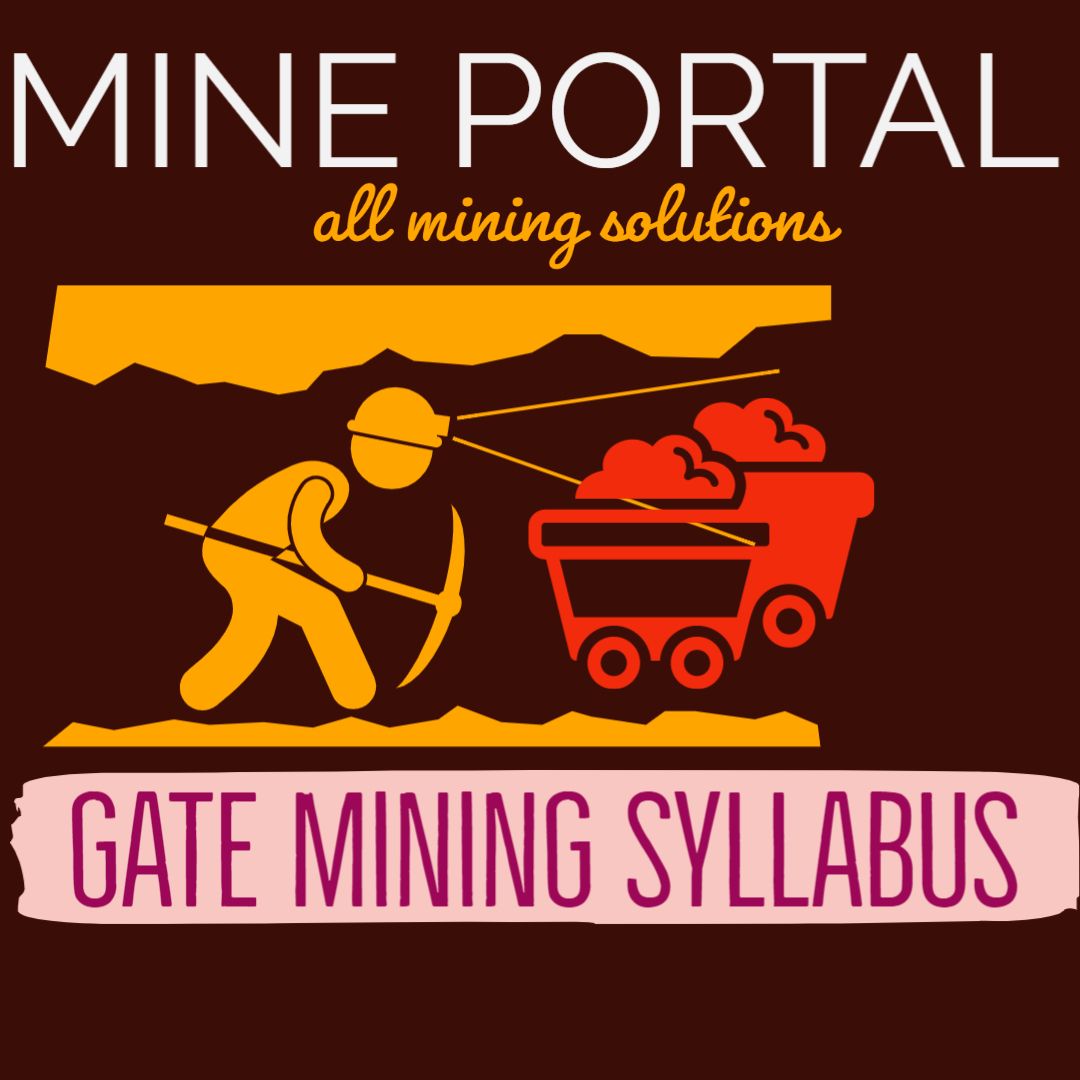
GATE MINING-2017 SYLLABUS
GATE MINING-2017 SYLLABUS
General Aptitude (GA)
Verbal Ability:
English grammar, sentence
completion, verbal analogies, word groups,instructions, critical reasoning and
verbal deduction.
Numerical Ability:
Numerical computation, numerical estimation, numerical reasoning and data interpretation.
CORE SECTION
Section 1: Engineering
Mathematics
Linear
Algebra: Matrices and Determinants;
Systems of linear equations; Eigen values and Eigen vectors.
Calculus: Limit, continuity and differentiability; Partial
Derivatives; Maxima and minima; Sequences and series; Test for convergence;
Fourier series.
Vector
Calculus: Gradient; Divergence and Curl; Line; surface and
volume
integrals; Stokes, Gauss and Green’s theorems.
Diferential
Equations: Linear and non-linear first order ODEs; Higher
order linear ODEs with constant coefficients; Cauchy’s and Euler’s equations.
Probability
and Statistics: Measures
of central tendency; Random variables; Poisson, normal and binomial
distributions; Correlation and regression analysis.
Numerical
Methods: Solutions of linear algebraic equations;
Integration of
trapezoidal and Simpson’s rule; Single and
multi-step methods for differential
equations.
Section 2: Mine Development
and Surveying
Mine
Development:
Methods of access to
deposits; Underground drivages; Drilling methods and machines; Explosives,
blasting devices and practices.
Mine
Surveying:
Levels and leveling,
theodolite, tacheometry, triangulation;Contouring; Errors and adjustments;
Correlation; Underground surveying; Curves; Photogrammetry; Field astronomy;
EDM and Total Station; Introductory GPS .
Section 3: Geomechanics and
Ground Control
Engineering
Mechanics: Equivalent force systems; Equations of
equilibrium; Two dimensional frames and trusses; Free body diagrams; Friction
forces; Particle kinematics and dynamics; Beam analysis.
Geomechanics: Geo-technical properties of
rocks; Rock mass classification; Instrumentation and stress measurement
techniques; Theories of rock failure; Ground vibrations; Stress distribution
around mine openings; Subsidence; Rock bursts and coal bumps; Slope stability.
Ground
Control:
Design of pillars; Roof
supporting systems; Mine filling.
Section 4: Mining Methods and
Machinery
Mining
Methods: Surface mining: layout, development, loading,
transportation and mechanization, continuous surface mining systems;
Underground coal mining: bord and pillar systems, room and pillar mining,
longwall mining, thick seam mining methods; highwall mining; Underground metal
mining: open, supported and caved stoping methods, stope mechanization, ore
handling systems.
Mining
Machinery:
Generation and transmission
of mechanical, hydraulic and pneumatic power; Materials handling: haulages,
conveyors, face and
development machinery, hoisting systems, pumps,
crushers.
Section 5: Surface
Environment, Mine Ventilation, and Underground Hazards
Surface
Environment:
Air, water and soil
pollution : Standards of quality, causes and dispersion of contamination, and
control; Noise; Land reclamation.
Mine
Ventilation:
Underground atmosphere; Heat
load sources and thermal environment, air cooling; Mechanics of air flow,
distribution, natural and mechanical ventilation; Mine fans and their usage;
Auxiliary ventilation; Ventilation planning; Ventilation networks.
Subsurface
Hazards:
Mine Gases. Underground
hazards from fires, explosions, dust and inundation; Rescue apparatus and
practices; Safety in mines; Accident data analysis; Mine lighting; Mine
legislation; Occupational safety.
Section 6: Mine Economics,
Mine Planning, Systems Engineering
Mine
Economics:
Mineral resource
classification; Discounted cash flow analysis; Mine valuation; Mine investment
analysis; Mineral taxation.
Mine
Planning:
Sampling methods, practices
and interpretation; Reserve estimation techniques: Basics of geostatistics and
quality control; Optimization of facility location; Work-study.
Systems
Engineering:
Concepts of reliability;
Reliability of simple systems;
Maintainability and availability; Linear
programming, transportation and
assignment problems; Network analysis; Inventory
models; Queueing theory; Basics of simulation.
Sample Questions
Verbal Ability
Q.1. Choose
the appropriate answer to complete the following sentence:
To those of
us who had always thought him timid, his --------- came as a surprise.
(A) intrepidity
(B) inevitability (C) inability (D) inertness
Ans. (A)
Q.2. Choose
the appropriate answer to complete the following sentence:
Medicine is
to illness as law is to _________
(A)
discipline (B) anarchy (C) treason (D) etiquette
Ans. (B)
Q.3. Read
the following paragraph :
“The
ordinary form of mercury thermometer is used for temperature ranging from –40oF
to 500oF. For measuring temperature below –40oF, thermometers filled with
alcohol are used.These are, however, not satisfactory for use in high
temperatures. When a mercury thermometer is used for temperature above 500oF,
the space above the mercury is filled with some inert gas,usually nitrogen or
carbon dioxide, placed in the thermometer under pressure. As the mercury rises,
the gas pressures is increased, so that it is possible to use these
thermometers for temperatures as high as 1000oF.”
With what,
besides mercury, would a thermometer be filled if it was designed to be used for
measuring temperature of about 500oF?
(A)
Pyrometer (B) Inert gas (C) Iron and brass (D) Gas
Ans. (B)
Q.4. The
cost of manufacturing tractors in Korea is twenty percent less than the cost of
manufacturing tractors in Germany. Even after transportation fees and import
taxes are added, it is still cheaper to import tractors from Korea to Germany
than to produce tractors in Germany.
Which of the
following assertions is best supported by the above information?
(A) Labour
costs in Korea are twenty percent below those in Germany.
(B)
Importing tractors into Germany will eliminate twenty percent of the
manufacturing jobs in Germany.
(C) The
costs of transporting a tractor from Korea to Germany is more than twenty
percent ofthe cost of manufacturing the tractor in Korea.
(D) The import
taxes on a tractor imported from Korea to Germanyis less than twenty
percentof
the cost of manufacturing the tractor in Germany.
Ans. (D)
Numerical
Ability
Q.5. In a
survey, 3/16 of the people surveyed told that they preferred to use
publictransport
while
commuting daily to office. 5/8 of the people surveyed told that theypreferred
to use their own vehicles. The remaining 75 respondents said thatthey had no
clear preference. How many people preferred to use publictransport?
(A) 75 (B)
100 (C) 125 (D) 133
Ans. (A)


No comments added yet!